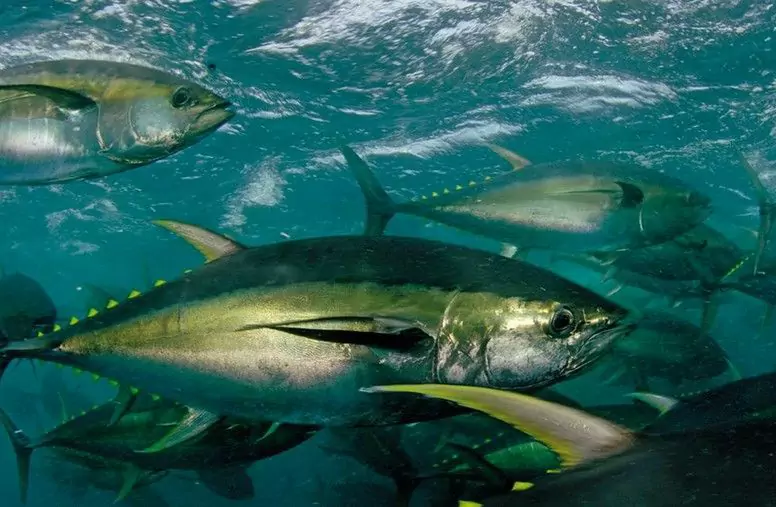Can dogs eat tuna? What are the nutritional benefits of tuna for dogs?
2022-07-08
Have you ever wondered if dogs can eat tuna just like cats? The quick answer is yes, they love to fish and tuna is one of their favorites. That said, are there benefits to dogs eating tuna? Every dog lover worries about their four-legged friends and always wonders if what they eat is bad for their health. In this article, we will tell you the benefits of tuna for dogs, how to choose the right tuna before feeding it to your dog, and how to feed it properly. Let's get started!
I. What are the beneficial nutrients of tuna for dogs?
Yes, you can feed your dog tuna because it can provide your pet with many good nutrients. Let's take a closer look at the benefits of tuna.
1. Protein
First, tuna is very low in calories and fat, which makes it one of the purest protein foods your dog can eat. Here are two of the main benefits of a balanced protein diet.
Prevents high blood pressure and cardiovascular problems.
Helps your dog build muscle and stay in good shape.
2. Omega-3
Tuna is a good source of omega-3 fatty acids.
Helps your dog have a healthy, smooth coat.
Prevents coat inflammation.
Prevents your dog's itchy skin.
Improves eye health. 3.
3. Vitamins
Finally, tuna is high in vitamins.
Vitamins B3, B6, and B12. These vitamins will provide your dog with energy and provide a strong immune system.
Magnesium protects against stress.
Potassium supports proper cell, nerve, and muscle function.
Selenium helps cleanse the body with antioxidants.
Vitamin D helps absorb calcium, which strengthens bones and teeth.
5 Types of Tuna Good for Dogs
There are more than 20 different species of tuna in the ocean. Here are the top 5 tuna species that we can make safe for your dog to eat.
Yellowfin tuna
Albacore tuna
Bigeye tuna
Bluefin tuna
Skipjack tuna
Please note that although tuna is very healthy, it can also contain significant amounts of mercury compared to most other fish. The tuna species most likely to carry large amounts of mercury are bluefin and bigeye.
II. Benefits of tuna for dogs
1銆丗atty acids in tuna fish flesh are mostly unsaturated fatty acids, contain many amino acids, and also contain vitamins, many minerals, and trace elements, which are rare and healthy food.
2, tuna fish contains DHA is the most in the fish, it is the brain and central nervous system development of essential nutrients. Do you know that there are many benefits for dogs to eating tuna?
3, tuna also contains a large amount of EPA, which can inhibit cholesterol increase and prevent atherosclerosis, and has a special role in the prevention and treatment of cardiovascular and cerebrovascular diseases.
4, regular consumption of tuna can clear the excess salt in the body, balance the water content in the body, and maintain the normal water index.
5, tuna nutrition ratio is good, low fat, low calorie, rich in high protein.
Edible tuna for pet dogs, the most outstanding value is rich in EPA and DHA.
DHA has the role of promoting brain function and growth and development of pet dogs, DHA is an important component of the brain cell membrane, involved in the formation and development of brain cells, has an important role in the extension of nerve cell axons and the formation of new protrusions, can maintain the normal physiological activities of nerve cells, involved in the process of brain thinking and memory formation.
DHA also has an anti-aging effect on pet dogs, improves blood circulation, reduces total serum cholesterol and LDL cholesterol, increases HDL cholesterol, can treat hyperlipidemia, atherosclerosis, etc. Do you know do not know that dogs eating tuna has many benefits
DHA Hain that anti-allergic allergic reaction can prevent allergic dermatitis, bronchial asthma, can improve retinal reflex function, prevent vision weakening, can reduce low hepatic neutral fat, prevent fatty liver, have an anti-cancer effect, can reduce blood sugar, relieve the symptoms of diabetes.
The uses of EPA are firstly to compensate for your dog's autoimmune deficiency and secondly to ensure the health of your dog's circulatory system. Food sources for your pet to get EPA are wild mackerel, sardines, and mackerel, or you can also add fish oil to your dog's food formula as EPA is also found in fish oil.

Three types of tuna that can be fed to dogs
Tuna can be prepared and cooked in a variety of ways. Let's look at the 2 main types of tuna to care for your pup.
1. Cooked tuna
First, you must clean the tuna. Once this is done, you can cook it at a high temperature to kill the bacteria. In other words, be careful not to overcook your tuna! Finally, you can feed your beautiful dog with this delicious dish, which guaranteed enjoyment.
2. Canned tuna
Canned tuna is the easiest option because it saves you a lot of time in the kitchen. Since canned tuna is usually dipped in oil or water, if you decide to buy some for your dog, you should read the ingredients on the can. Also, make sure it does not contain any additives.
Can I feed raw tuna to my dog?
Raw tuna contains a lot of dangerous bacteria and viruses that can make your dog sick. In addition, it contains an enzyme called thiaminase, which can render him or her inactive. For this reason, raw tuna is not recommended under any circumstances.
That being said, some people give their dogs small amounts of raw tuna and never have a problem. Nonetheless, we still do not recommend it. If you decide to go ahead and eat raw fish, make sure you have deboned the tuna before giving it to your dog (the same applies if you cook it).
How much tuna should I feed my dog?
You may be wondering how much tuna is good for your dog? There is no real quick answer to this question as it depends largely on your dog's weight. If you give your dog too much tuna, it can put his health at risk because tuna sometimes contains too much mercury, as we explained before.
To keep your dog healthy and happy, follow these guidelines.
If your dog weighs about 20 pounds, you can feed a can of any kind of tuna every 3 weeks. However, if you feed your dog albacore tuna, do so once every 10 weeks.
If your dog weighs about 40 pounds (medium-sized dog), you can feed one can every 9-10 days. However, if you are feeding your dog albacore tuna, please feed it every 4 weeks.
If your dog weighs close to 90 pounds or more, then one can of tuna every 5 days be sufficient.
If your dog weighs more than 150 pounds (extra large dogs), you can feed tuna every 3 days. For albacore tuna, feed it to your dog every 9 days.
Fourth, can dogs eat canned tuna?
Canned tuna is a wet food and is a great nutritional product for cats. Of course, some owners give their dogs canned tuna, and although the dogs still like it a little bit now and then, the risks involved we can't ignore regardless. That is to say, dogs can not eat canned tuna, there are typically three kinds of risk, the following to give you a detailed explanation!
Risks when dogs eat canned tuna
The main material of canned tuna is tuna and bonito. The meat of these fish is taken for frying or boiling, and the taste is so delicious that it is often sold as human food as well. Since this kind of canned food is made for pets, few owners will refuse to buy it, because their pets like to eat it. So what do dogs need to pay attention to when they eat this kind of canned food?
1. The risk of salt, oil, and grease
Canned tuna, in a nutshell, there are a variety of types. Even if you want to give your dog to eat you should first understand the ingredients, what is too much content is not good for your dog's body. If it is salty, I think both people and dogs should be careful not to consume too much, because excessive intake can lead to high blood pressure in humans. The same for salty dogs should be more careful, the human body and the dog's body are different, so the reaction to salt will be different.
For dogs, excessive salt consumption carries the risk of salt poisoning, which can cause excess potassium that can lead to heart disease and heart failure in dogs. On the other hand, an excessive salt restriction may have a detrimental effect on the salt deficiency. The National Research Council (NRC), which is considered the standard for nutritional requirements of dogs, recommends a daily salt intake of 2.4 to 4.84 grams for dogs between 10 and 20 kg.
2. Methylmercury risk
Tuna, an ingredient in canned food, contains more mercury (methylmercury) than other fish and, as with humans, excessive consumption by dogs can only harm their central nervous system. All fish and shellfish do not contain methylmercury, but animals in the upper part of the marine food chain, supposedly the longer-lived animals, contain high levels of methylmercury.
According to the Japanese Ministry of Health and Labor 2005 revised " Precautionary measures for pregnant women eating fish and shellfish" indicates that the general public (especially pregnant women, infants, and those planning to get pregnant soon) is recommended to consume foods with high mercury content as a supplement to their bodies, once or twice a week. But giving too much is a bad choice for a dog's body.
3. Risk of allergy
There are also breeds of dogs that have allergic reactions to tuna and bonito, which are used as raw materials. If your dog accidentally eats canned tuna, it will show symptoms such as mental discomfort and bloodshot eyes, so please talk to your veterinarian as soon as possible to find a relative solution. At this time, you need to tell the veterinarian when you ate, what kind of fish you ate, and how much you ate, then the diagnosis given will be much smoother.
Was this article helpful to you?
Other links in this article
español :
¿Pueden los perros comer atún? ¿Cuáles son los beneficios nutricionales del atún para los perros?
Italiano:
I cani possono mangiare il tonno? Quali sono i benefici nutrizionali del tonno per i cani?
português (Brasil):
Os cães podem comer atum? Quais são os benefícios nutricionais do atum para cães?
中文简体:
狗能吃金枪鱼吗?金枪鱼对狗有哪些有益的营养?
中文繁体:
狗能吃金槍魚嗎?金槍魚對狗有哪些有益的營養?
Comments

Is a dog's mouth cleaner than a human's? Dogs' mouths need regular cleaning

Can dogs eat beans? Do dogs eat beans for health?

Can dogs eat lemons? Fruits that dogs should not eat more of

Do dogs have nightmares? Are dogs' dreams similar to humans'?

Can dogs eat raw beef? The benefits and drawbacks of beef for dogs

Is raw meat good for dogs? Can dogs eat raw chicken?

Can dogs eat pomegranates?

Can dogs eat ham?Can all types of ham hocks be eaten?

How to give a dog a bath

Can dogs eat kimchi?










